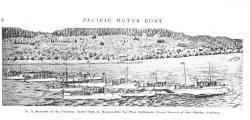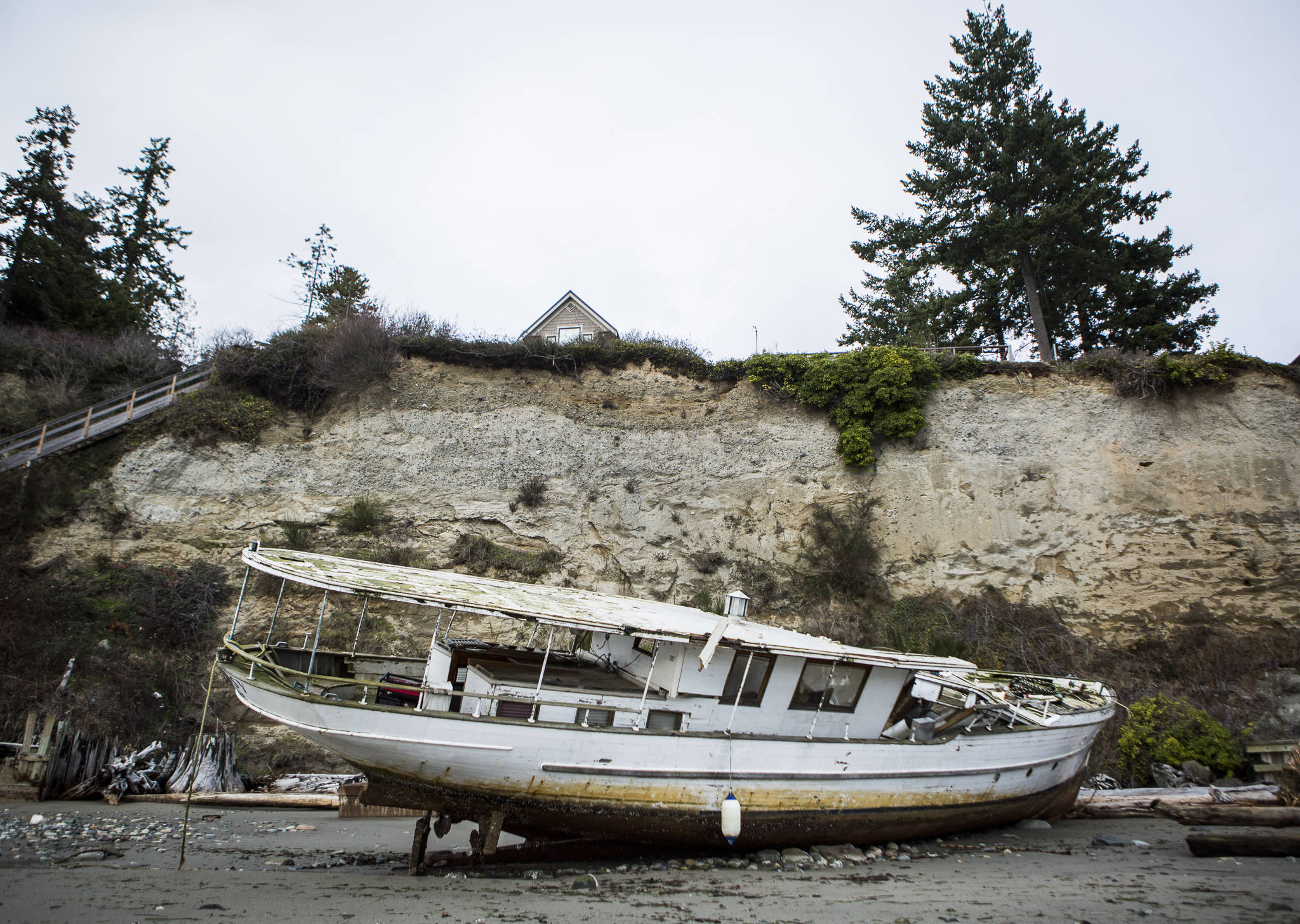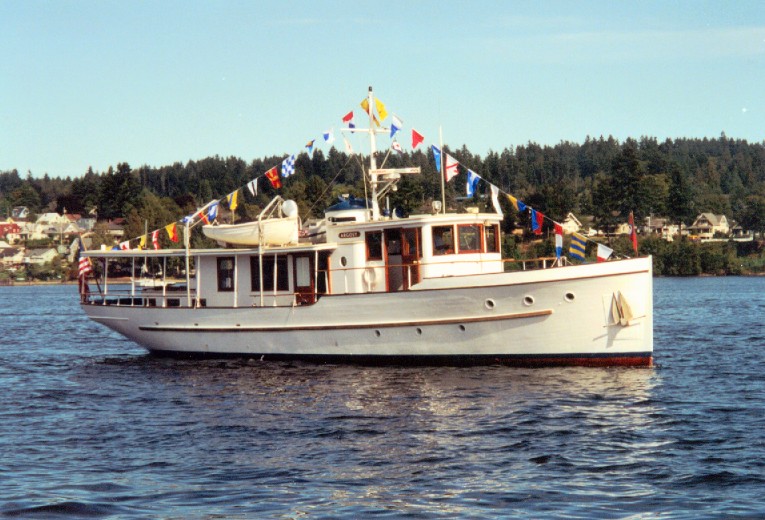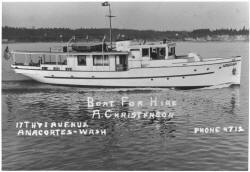Historical Summary:
Tales of the Good Ship Argosy
by Rick Etsell
Argosy has been through a lot in her long years. When built she was the pride of the fleet at the Tacoma Yacht Club, and spent most summers cruising to Alaska. Then, in the early thirties, she was the scene of a terrible tragedy when she blew up and sank, killing her owner. She's one of those boats, though, that somehow manage to pull themselves together again to live long and happy lives. She was refloated, redesigned, and rebuilt, then went on to spend three years patrolling Puget Sound for the Coast Guard, plus 33 years in charter service.
The owner was Dr. Edward A. Rich, an orthopedic surgeon specializing in bone and joint diseases, and a past-commodore of the Tacoma Yacht Club. He commissioned the well known Philadelphia naval architect, J. Murray Watts, to design the boat based on his requirements. An article in Pacific Motorboat said: "A glance at the plans shows a craft of unusual navigating prowess as well as exceptional sea-going qualities. An adequate flare just above the waterline and plenty of beam forward of the junction of the first and middle thirds have been demands of the owner, who has had a great deal of experience in cruising the waters of British Columbia and Alaska and is thoroughly familiar with the type of craft best suited to this territory. The whole aim of construction has been to keep the lines yacht-like and the superstructure low and well down in the water."
 She was built at Edward E. Johnson's boatyard in Tacoma, and launched in late 1925. Power was by twin four cylinder Western-Wright gasoline engines developing 50 horsepower each. During the Alaska Gold Rush, which occurred only 27 years before, the intrepid fortune seekers who fought their way to the gold fields were labeled "Argonauts". Dr. Rich appears to have been paying tribute to these men by naming his new boat "Argosy", and he regularly referred to his crew members as "Argonauts". The adventure magazine "Argosy" was also very popular at the time, which could also have been an influence in the decision.
She was built at Edward E. Johnson's boatyard in Tacoma, and launched in late 1925. Power was by twin four cylinder Western-Wright gasoline engines developing 50 horsepower each. During the Alaska Gold Rush, which occurred only 27 years before, the intrepid fortune seekers who fought their way to the gold fields were labeled "Argonauts". Dr. Rich appears to have been paying tribute to these men by naming his new boat "Argosy", and he regularly referred to his crew members as "Argonauts". The adventure magazine "Argosy" was also very popular at the time, which could also have been an influence in the decision.
The Alaska Cruiser Race, 1928
 June 26, 1928 saw the start of the first Capital to Capital race from Olympia, Washington to Juneau, Alaska. At 908 miles, it was the longest race of its kind ever held in the U.S., and was the first on the Pacific Coast to be sanctioned by the American Power Boat Association. Dr. Rich was one of the organizers and Argosy was the largest of the ten boats in the race, which also included Leota, Sandpiper, Bolinder, Dolphin II, Maidie, Yankee Boy, Winifred (Adolph Shmidt's Lake Union Dreamboat, whose crew included the famous Charles F. Chapman), Dell, and Shoo-Fly (a 28-footer!).
June 26, 1928 saw the start of the first Capital to Capital race from Olympia, Washington to Juneau, Alaska. At 908 miles, it was the longest race of its kind ever held in the U.S., and was the first on the Pacific Coast to be sanctioned by the American Power Boat Association. Dr. Rich was one of the organizers and Argosy was the largest of the ten boats in the race, which also included Leota, Sandpiper, Bolinder, Dolphin II, Maidie, Yankee Boy, Winifred (Adolph Shmidt's Lake Union Dreamboat, whose crew included the famous Charles F. Chapman), Dell, and Shoo-Fly (a 28-footer!).
 At the time, such an event was no small affair -- The Coast Guard Cutter Snohomish was assigned to escort the boats for the length of the trip, and virtually the whole city of Olympia was on hand to see them off at the start of the race. A float plane dropped an aerial bomb as a starting signal. Each boat carried copies of letters from the Mayor of Olympia and the Governor of Washington, which were to be hand delivered to their respective counterparts in Juneau by the crew of the first boat to finish. Although the race was to include ample time-outs for layovers, the incentive to be the first in was great and they ended up running almost continuously day and night, reaching Juneau just four to six days later. Argosy finished fourth overall, and second in her class. Dr. Rich wrote extensively in Pacific Motorboat about the race and about plans for future races.
At the time, such an event was no small affair -- The Coast Guard Cutter Snohomish was assigned to escort the boats for the length of the trip, and virtually the whole city of Olympia was on hand to see them off at the start of the race. A float plane dropped an aerial bomb as a starting signal. Each boat carried copies of letters from the Mayor of Olympia and the Governor of Washington, which were to be hand delivered to their respective counterparts in Juneau by the crew of the first boat to finish. Although the race was to include ample time-outs for layovers, the incentive to be the first in was great and they ended up running almost continuously day and night, reaching Juneau just four to six days later. Argosy finished fourth overall, and second in her class. Dr. Rich wrote extensively in Pacific Motorboat about the race and about plans for future races.
These good times for Dr. Rich and the Argosy came to a tragic end in March of 1933. The story goes that Dr. Rich had topped off the gas tanks during a gas war when the price had dropped to 10 cents a gallon. Soon after, Dr. Rich and a mechanic went aboard, whereon the mechanic commented on a strong odor of gasoline. Dr. Rich discounted the smell and proceeded to light a cigarette, which scared the mechanic, who then left the boat. About 15 minutes later, she blew. Dr. Rich was pulled from the wreckage, but died several days later in a Tacoma hospital. Argosy sank at her moorings, but was later raised by Barney Wright of Western Wright Marine. (The Tacoma Daily Ledger March 20, 1933 )
The newspaper accounts of the tragedy don't shed any light on the cause, but a few months after it happened Pacific Motorboat ran an article on "Protecting Your Boat Against Fire", containing this statement: "In no case should the [fuel] filling pipe be stopped below the deck or inside the hull... The recent tragic death of a well-known Tacoma yachtsman was said to be due entirely to an explosion resulting from this sort of faulty filling-pipe installation."
Re-birth
 In the Summer of 1934, Mr. Elliott Higgins and his son, Elliott Jr. were planning to build a boat for living aboard as well as extended Alaska cruises. They happened on the Argosy, and saw a chance to save some time by building from an existing hull. A survey showed the hull to be in good condition, so the younger Mr. Higgins, who was a mechanical engineer with naval architecture training, went to work and laid out a completely new deckhouse structure. (According to Coast Guard records, the purchase price was $350.)
In the Summer of 1934, Mr. Elliott Higgins and his son, Elliott Jr. were planning to build a boat for living aboard as well as extended Alaska cruises. They happened on the Argosy, and saw a chance to save some time by building from an existing hull. A survey showed the hull to be in good condition, so the younger Mr. Higgins, who was a mechanical engineer with naval architecture training, went to work and laid out a completely new deckhouse structure. (According to Coast Guard records, the purchase price was $350.)
The rebuild was done at Jensen Motorboat Company on Seattle's Portage Bay, and was extensive, involving rebuilding and raising the decks, all new houses, machinery, etc. Mr. Higgins, Jr. wrote an article about it for Pacific Motorboat Magazine. Four years were spent on the project, when a change of plans by the senior Mr. Higgins necessitated selling the boat. The war was coming on and he was transferred to another part of the country. The boat was still without engines, and a full-page ad was placed in Pacific Motorboat offering "This Partially Completed Yacht is For Sale." Thus, Mr. Higgins never got to use the boat he spent so much time in rebuilding. He still lives in Seattle, and I have been fortunate to have been able to meet with him and hear firsthand about the rebuilding project. In June of 1999, he was our guest for an afternoon cruise, where he was finally able to take the helm for the first time -- 61 years after parting with her!
A Mr. John Willson bought the boat in April of 1940, finished it off and installed a pair of Universal gas engines. (Higgins had planned on putting diesels in, and was aghast that Wilson used gas again after what had happened.)
CGR-789
During World War II, many private yachts were donated to the Navy or Coast Guard for domestic patrol duties. (See side bar.) My guess is that Mr. Wilson died shortly before the war started, since the Coast Guard records show ownership transferring to Pearl Wilson, who I assume was his widow. Mrs. Willson donated the boat to help the war effort, and Argosy was commissioned into the Coast Guard Reserves as CGR-789 in April 1942. The Coast Guard lists her as being in active service from 4/42 to 11/44, then surplused in April 1945. There is evidence that the Coast Guard removed the fantail canopy and side deck covers.
The surplus vessel was purchased by O.H. "Doc" Freeman and Russell G. Gibson in August of 1945. In October of the same year they sold her to Mr. Alf Christiansen, who originally took her to Portland, where he lived aboard. Later, he brought her back to Puget Sound, using Anacortes as home base for a charter business running cruises to Alaska. (On the way back from Portland, in June of 1960, Argosy lost steering as was blown ashore near Neah Bay. A photo shows her hard aground in the sand, but she was reportedly refloated with no damage.) He replaced the gas engines with the current Gray Marine 6-71 diesels. At 165 hp each, they are over three times the original power, and are well in excess of the size needed to achieve hull speed of about 10 knots.
Recent Years
In October 1978, Mr. Christiansen sold the boat to a retired Navy commander, Bill Palmer and his wife Alta. The Palmers used her for several lengthy cruises to Alaska, from their moorage at the Port Orchard Yacht Club. Mr. Palmer added new electronics and other equipment and rebuilt the Gray Marines.
In 1994, Nancy and Tim Wistrom purchased Argosy from the Palmers, planning to live aboard. At this time, however, the boat was in need of substantial repairs. Water had leaked into the stack area and rotted a substantial portion of the cabin top and aft wheelhouse bulkhead. Additionally, quite a few planks and some frames were in need of replacement, decks were badly in need of renewing, and many other systems needed extensive work.
It turned out to be more work than was possible while living aboard, so Nancy's brother and sister-in-law, Rick and Jackie Etsell bought the boat and began a major refurbishment. This work included substantial planking and frame replacement and sistering, deck and beam repairs, cabin top repair and renewal, complete re-wiring, etc. We completely wooded the entire hull and cabins (many areas still had wartime gray underneath!), and rebuilt much of the interior. The focsle area, which had been turned into a generator room, was made back to the original configuration as a bunk room (originally for crew, now for kids!) I also made a few small changes to the interior layout. A bulkhead between the saloon and galley was eliminated to open both areas up more. Also, the passageway from the saloon to the wheelhouse was changed from the port to the starboard side, so that a pilot seat could be installed -- something that was lacking before.
After 11 years of ownership, the Etsells passed Argosy on to new caretakers in 2005.
Final Disposition
Since 2005, Argosy went through at least 4 different owners, some of whom attempted to maintain her. But her condition worsened progressively as she was left anchored out in various channels and bays, most notably several years spent just outside of the navigation channel in the Swinomish Slough near La Conner (Washington.). Sometime during the week of January 13, 2020, Argosy broke loose in a wind storm and drifted onto the beach on the Tulalip Indian Reservation north of Everett, Washington. Her wheelhouse collapsed into the hull and the hull structure was severely compromised. Argosy was broken up in February 2020.
RIP, Good Ship Argosy!

See the Everett Herald article about the wreck here.




![Argosy at Longbranch 2002. [Rick Etsell photo]](https://classicyachtinfo.org/sites/default/files/styles/thumb_300w_scaled/public/1891075_466064786830815_1055918663_n1.jpg)
![Argosy at Penrose Point State Park, South Puget Sound. [Rick Etsell photo]](https://classicyachtinfo.org/sites/default/files/styles/thumb_300w_scaled/public/argosy-penrose_0.jpg)
![Argosy Fantail. [Rick Etsell photo]](https://classicyachtinfo.org/sites/default/files/styles/thumb_300w_scaled/public/argosy6.jpg)
![Argosy in Fremont Cut. [Peter Aden photo]](https://classicyachtinfo.org/sites/default/files/styles/thumb_300w_scaled/public/cut1_aden.jpg)